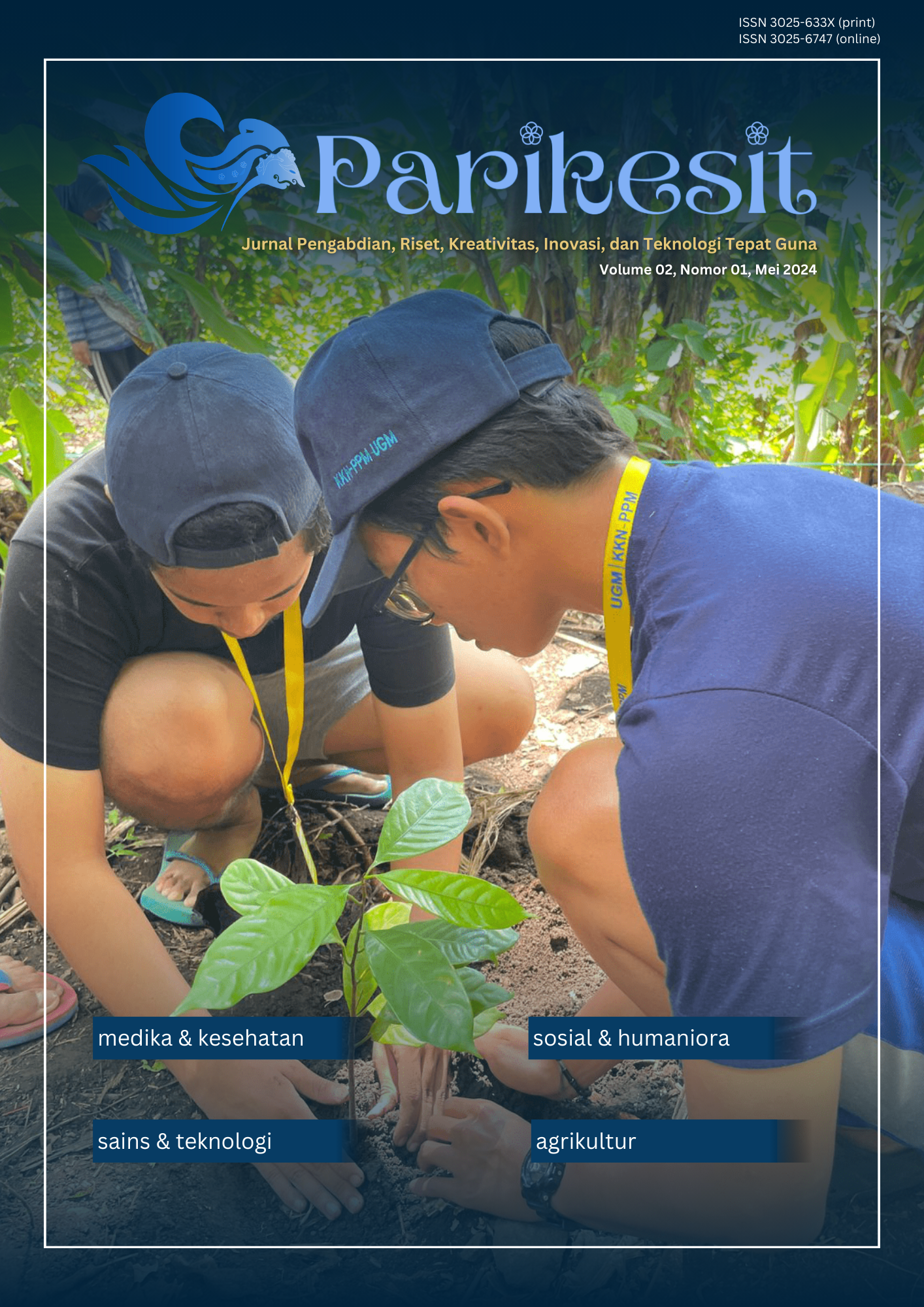Eye Health Promotion through Eye Screening Activities for Junior High School Students in Wedung District, Demak
Abstract
The eyes play an important role in a student's life. When eye problems occur, there can be a decrease in visual acuity, which can impact the student's quality of life. This can be characterized by blurry eyes when looking at the blackboard or looking far away. Student activities often involve prolonged staring at close objects, such as reading, doing assignments, or using devices such as smartphones and laptops. Without realizing it, these habits become a risk factor for a student to experience refractive error in the form of myopia, or nearsightedness. Students who experience myopia often do not realize it, so as an effort to maintain eye health, it is necessary to conduct eye screening to find out whether students experience refractive disorders or not, including in Wedung Subdistrict which is the location of KKN-PPM UGM unit JT-13. In order to carry out community service, eye screening is carried out for junior high school students. Located in 4 junior high schools in Wedung Sub-district, visual acuity (visus) was measured using the Snellen chart. A total of 300 junior high school students were examined, 55 of whom had decreased visual acuity. After each examination, students were educated on how to maintain eye health. In students with decreased visual acuity, risk factors were explored. This article is designed to describe how the eye health screening was conducted, the condition of some junior high school students with decreased visual acuity, and the risk factors that may cause refractive errors. Data collection was done by listing the results of each school's visus examination and history taking after the examination. The results of the visual acuity examination were analyzed using a descriptive quantitative method, while the interview data were analyzed using a qualitative method. Eye screening in junior high school students is expected to be a health promotion tool for both students with refractive errors and those without, as a reminder to maintain their eye health. For students with refractive errors, the screening can be a prelude to further examination so that students get immediate treatment, which can be in the form of refractive correction with the use of glasses, so that the refractive error that occurs doesn't getting worse.
References
Baird, P.N., Saw, S. M., Lanca, C., Guggenheim, J. A., Smith III, E. L., Zhou, X., Matsui, K. M., Wu, P., Sankaridurg, P., Chia, A., Rosman, M., Lamoureux, E. L., Man, R., & He, M. (2020). Myopia. Nature Reviews Disease Primers, 6(99). https://doi.org/10.1038/s41572-020-00231-4
Caltrider, D., Gupta, A., & Tripathy, K. (2023). Evaluation of visual acuity. StatPearls Publishing. https://www.ncbi.nlm.nih.gov/books/NBK564307/
Congdon, N., Burnett, A., & Frick, K. (2019). The impact of uncorrected myopia on individuals and society. Community eye health, 32(105), 7—8.
Flitcroft, D. I., He, M., Jonas J. B., Jong, M., Naidoo, K., Ohno-Matsui, K., Rahi, J., Resnikoff, S., Vitale, S., & Yannuzzi, L. (2019). IMI - Defining and classifying myopia: A proposed set of standards for clinical and epidemiologic studies. Investigative ophthalmology & visual science, 60(3), 20–30. https://doi.org/10.1167/iovs.18-25957
Givler, D. N., & Givler, A. (2023). Health skrining. StatPearls Publishing. https://www.ncbi.nlm.nih.gov/books/NBK436014
Grzybowski, A., Kanclerz, P., Tsubota, K., Lanca, C., & Saw, S. M. (2020). A review on the epidemiology of myopia in school children worldwide. BMC ophthalmology, 20(1), 27. https://doi.org/10.1186/s12886-019-1220-0
Guan, H., Yu, N. N., Wang, H., Boswell, M., Shi, Y., Rozelle, S., & Congdon, N. (2019). Impact of various types of near work and time spent outdoors at different times of day on visual acuity and refractive error among Chinese school-going children. PloS one, 14(4), 1—13. https://doi.org/10.1371/journal.pone.0215827
ICD 11. (2023). 9D90 vision impairment including blindness. World Health Organization. https://icd.who.int/browse11/lm/en#/http%253a%252f%252fid.who.int%252ficd%252fentity%252f1103667651
Inchara, N., Jammula, S. M., & Praveen Kumar B A. (2023). Exposure to electronic gadgets and refractive errors among adolescents: A case–control study. Pan Am J Ophthalmol. Diakses pada 28 September 2023 melalui https://www.thepajo.org/text.asp?2023/5/1/4/369999
Leng, L., Zhang, J., Xie, S., Ding, W., Ji, R., Tian, Y., Long, K., Yu, H., & Guo, Z. (2021). Effect of Sunshine Duration on Myopia in Primary School Students from Northern and Southern China. International Journal of General Medicine, 14, 4913—4922. https://doi.org/10.2147/IJGM.S328281
Mahayana, I. T., Indrawati, S. G., & Pawiroranu, S. (2017). The prevalence of uncorrected refractive error in urban, suburban, exurban and rural primary school children in Indonesian population. International Journal of Ophthalmology, 10(11), 1771—1776. https://doi.org/10.18240/ijo.2017.11.21
Morgan, I. G., Wu, P. C., Ostrin, L. A., Tideman, J. W. L., Yam, J. C., Lan, W., Baraas, R. C., He, X., Sankaridurg, P., Saw, S. M., French, A. N., Rose, K. A., & Guggenheim, J. A. (2021). IMI Risk Factors for Myopia. Investigative Ophthalmology & Visual Science, 62(5), 3. https://doi.org/10.1167/iovs.62.5.3
Optician UK. (2023). Element of refraction. Diakses pada 19 Agustus 2023 melalui https://www.opticianonline.net/cpd-archive/11
Subudhi, P. & Agarwal, P. (2023). Myopia. Treasure Island (FL): StatPearls Publishing. https://www.ncbi.nlm.nih.gov/books/NBK580529/
Tang, S. M., Zhang, X. J., Wang, Y. M., Zhang, Y., Wong, L. M., Chan, H. N., Zhang, B. N., Chu, W. K., Kam, K. W., Young, A. L., Tham, C. C., Chen, L. J., French, A. N., Rose, K. A., Pang, C. P., & Yam, J. C. (2023). Effect of myopic undercorrection on habitual reading distance in schoolchildren: The Hong Kong children eye study. Ophthalmology and therapy, 12(2), 925–938. https://doi.org/10.1007/s40123-022-00628-2
WHO. (2022). Be he@lthy, be mobile: A toolkit on how to implement MyopiaEd. World Health Organization. Diakses pada 19 Agustus 2023 melalui https://www.who.int/publications/i/item/9789240042377
Copyright (c) 2024 Jurnal Pengabdian, Riset, Kreativitas, Inovasi, dan Teknologi Tepat Guna

This work is licensed under a Creative Commons Attribution-ShareAlike 4.0 International License.




